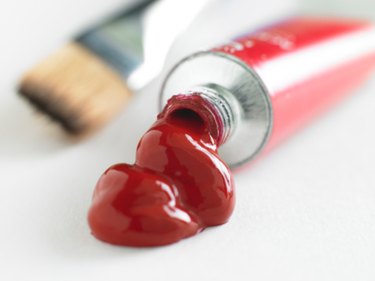Things You'll Need
Acrylic paints
Paintbrush
Palette
Paper
Color wheel (optional)

Mixing acrylic paints to generate new values allows you to produce a unified progression of color in the completed artwork. In the same way that pencil drawings use shading to add depth, incorporating darker and lighter values of one color, such as vermilion and crimson, adds dimension to the figures on a canvas. You can create darker shades of red by mixing in black or another dark color, such as blue or green. For a dark red with a slightly softer tone, alter the color with dark gray.
Preparation
Step 1
Use the color wheel to determine the best value of red to begin with if you have a variety to choose from. Keep in mind that the starting value of your red paint will determine the result after mixing. For example, darkening a red value with an orange undertone will result in a value closer to brown than black.
Video of the Day
Step 2
Add the red paint you want to start with to the palette. It isn't necessary to use a large amount of paint, but use enough to preserve the moisture of the paint. A thin layer of acrylic paint will dry up very quickly.
Step 3
Use a paintbrush to take a small sample of the starting value and make a thin stroke of paint on the paper. You will use this paper to track the progression of shades and tones as you alter the original color. It is also useful as a guide if you need to produce the same value in the future.
Mixing Shades and Tones
Step 1
Choose the color you want to use to darken your paint. Add a very small amount of the dark paint onto the brush and mix it evenly into the red paint. Controlling the amount of dark paint you add allows you test as many values as possible.
Step 2
Take a small sample of the new value and make a mark on the paper right next to the original value so that the edges meet. Take samples of the darkened values and add them to the paper each time you add more dark paint to the original color. Try to add the same amount of dark paint to the red color each time.
Step 3
Keep adding dark paint until you achieve the desired value. Use the sample sheet to compare the new value to the original color. You may need to repeat the process with a different darkening value to get the color you want.
Tip
As you become more experienced with mixing paint and determining the value you want to achieve, it isn’t always necessary to create a sample sheet. However, a sample sheet can be used again and again as a guide for different painting projects. The sample chart gives you an indication of how much dark paint to add without going through the extend process of mixing each time.
You can add a little water to the paint if it starts to dry up while you are mixing.
Video of the Day